As a kid, your parents likely tried to find creative ways to add vegetables into dishes, just to get you to eat them.
Now, adults seem to be really keen on doing it to themselves, too! There is cauliflower in our mashed potatoes, squash in our macaroni & cheese, peas in our guacamole, and apple sauce in our cake. We love to "healthify" recipes – especially around the New Year.
So, what's the problem? Shouldn't a dietitian, like myself, be thrilled that people want to eat more vegetables and fruits? Of course! But trying to healthify all of your favourite recipes can backfire on you. Here's how:
1. Your food might not taste as good

Egg white omelettes and cauliflower mashed potatoes have less calories than the traditional versions of these dishes. But what if you don't like how they taste? Taste is a key driver in our food choices, and it is important to consider. However, the opposite can also be true. I love the flavour peas added to guacamole, for example. So I don't just add them in because it reduces the calories in a serving.
Make sure you don't sacrifice the enjoyment of a dish, just to reduce the amount of carbohydrates or fat in it. You will likely end up leaving the table feeling deprived and still craving the real deal. Be especially careful with baking. You can only mess with the chemistry of a recipe so much before ruining it.
The takeaway: If you are forcing yourself to eat a meal because you think it is healthy – stop. Making healthful choices is important, but enjoying your food is important, too. Seek options that fit your health goals and please your taste buds, so that you're motivated to continue making healthy choices.
2. You may end up eating more calories

Thinking a food is a healthier choice may actually lead you to eating more calories. In a recent study, participants ate more chocolate and rated it as tasting better when it was labelled "fair trade," compared to the same chocolate without the "fair trade" label. People underestimate the calories in foods that they perceive as being healthier, and often choose higher calorie side dishes or desserts if they chose a "healthy" main dish.
Just because you added a quarter cup of squash to your macaroni and cheese, doesn't mean you should have three servings if you were comfortably full after one or two. You're likely to eat more chips if they say "baked" instead of "fried" on the package. Ultimately, you may end up eating just as many (if not more) calories, while feeling less satisfied.
This "health halo" effect is common for many foods. Terms such as organic, gluten free, artisan, fat free, baked, natural, real and so on, automatically make people think the food is a better choice, which may lead to eating more of it.
Remember the low fat craze? Low fat foods were thought to be healthier for us, when many of them were similar in calories and had more sugar! Low fat labels on foods may actually cause a higher calorie intake. Reduced fat peanut butter is a perfect example of a food that many bought thinking it was a healthy choice, when natural peanut butter is actually much better for us.
The takeaway: Don't eat past comfortably full just because you think a food is healthy. It likely has more calories than you think and, yes, it is possible to overeat healthy foods.
3. Your budget may suffer

Many foods that are boasted as more healthful options can be quite expensive. Fancy sweeteners (e.g. agave syrup), quinoa, unique oils, dairy-free "cheeses" and so on, are pricier choices that are not essential to a healthful diet.
Your good intentions may also cause more food waste. If you buy fat free yogurt and low fat cheese, only to let them go bad in the fridge, you may want to rethink your strategy. The same goes for the slimy kale sitting in your crisper. If you're going to buy foods you don't normally eat, make a plan around how you will use them first. Why not try a new recipe?
The takeaway: Stay within your means. You don't need to spend extra money on specialty ingredients to make recipes healthier. Keep it simple!
4. You may be missing out on healthful foods

Many of the ingredients we are swapping out for so-called healthier ones are actually full of nutrients. I cringe when I think back to my (thankfully short lived) days of throwing out egg yolks and buying non-fat salad dressing. Think about what you are swapping out before you do it. Sure, you can swap almond milk for cow's milk if you prefer, but you will lose some high quality protein. Many low fat versions of foods exchange healthy fats for added sugar.
The takeaway: Think twice before replacing ingredients in a recipe. The original recipe may actually be a better choice.
Rather than resolving to lose X amount pounds by X day, resolve to eat in a way that makes you feel good and is enjoyable.
I am definitely on board with your plan to eat more vegetables and fruits this year, but keeping the balance of enjoyable, affordable and nutritious is key. If you enjoy cauliflower in your mashed potatoes – great! If not, stick with regular mashed potatoes and enjoy them!
Also on HuffPost
